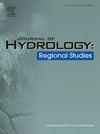Modelling the Isotope composition of groundwater using hydrochemical properties in eastern Saudi Arabia: Implementation of innovative data intelligence techniques
IF 4.7
2区 地球科学
Q1 WATER RESOURCES
引用次数: 0
Abstract
Study region
Al-Qatif coastal region in eastern Saudi Arabia is an arid region with limited surface water resources and vulnerable to seawater intrusion.
Study focus
The study focused on modelling and prediction of the isotope composition (δ¹⁸O and δ²H) of coastal groundwater using Artificial Intelligence (AI) models utilizing readily available groundwater hydrochemical dataset. The study aims to understand the geochemical evolution of groundwater and the impact of seawater intrusion on arid coastal environment.
New hydrological insight for the region
Eight AI algorithms (KNN, SVR, RF, ET, Bag, AdaBt, GRB, and CAT) and stacking ensemble models were developed to predict the δ¹ ⁸O and δ²H isotopes of the groundwater using a dataset of physicochemical parameters, ions and elements, and isotopes from 47 wells. The study shows that the stacking ensemble models outperformed individual algorithms. The optimum model for δ¹ ⁸O (O_M1) was achieved with R² of 0.9858, MAE of 0.0440, and Pearson correlation of 0.9941. for δ²H the optimal model (H_M1) was achieved with R² of 0.9317, MAE of 0.5334, and Pearson correlation of 0.9658. The significant relationship between hydrochemical parameters and isotopic composition indicate that the variation in groundwater chemistry is mostly associated with mixing processes, primarily driven by seawater intrusion in the coastal region. The study demonstrates the potential of AI-based models to predict the isotopic signature and groundwater dynamics in similar coastal arid environments.
求助全文
约1分钟内获得全文
求助全文
来源期刊

Journal of Hydrology-Regional Studies
Earth and Planetary Sciences-Earth and Planetary Sciences (miscellaneous)
CiteScore
6.70
自引率
8.50%
发文量
284
审稿时长
60 days
期刊介绍:
Journal of Hydrology: Regional Studies publishes original research papers enhancing the science of hydrology and aiming at region-specific problems, past and future conditions, analysis, review and solutions. The journal particularly welcomes research papers that deliver new insights into region-specific hydrological processes and responses to changing conditions, as well as contributions that incorporate interdisciplinarity and translational science.
 求助内容:
求助内容: 应助结果提醒方式:
应助结果提醒方式:


